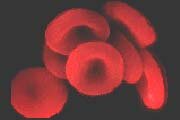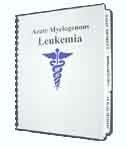 |
||
| HOME | ||
 |
||
| Acute Myelogenous Leukemia (AML) |
||
 |
||
| Other Leukemia Types (ALL / CLL / CML / HCL) |
||
 |
||
| Myelodysplastic Syndrome | ||
 |
||
| Symptoms and Diagnosis | ||
 |
||
| Leukemia Treatment Options | ||
 |
||
| " Chemotherapy | ||
 |
||
| " Blood Stem Cell Transplants | ||
 |
||
| " Radiation and Surgery | ||
 |
||
| " Chemo Side Effects | ||
 |
||
| " Clinical Trials Info | ||
 |
||
| " Coping with Leukemia | ||
 |
||
| " What to Ask Your Doctor | ||
 |
||
| Financial Assistance | ||
 |
||
| At Risk Jobs/Exposure | ||
 |
||
| Leukemia Resources | ||
 |
||
| Survivor's Story | ||
 |
||
| Leukemia News | ||
 |
||
|
Search for information:
|
||

|
Leukemia Cancer News - Return to Menu Myelodysplastic (MDS) Syndrome and Leukemia After Autotransplantation for Lymphoma: a Multicenter Case-Control Study Diana Stripp, MD University of Pennsylvania Cancer Background: - Increased survival has been seen in pateints with Hodgkin?s disease and Non-Hodgkin?s lymphoma who underwent autotransplantation, with a 40-50% long-term disease-free-survival rate. - However, previous reports indicate that pts receiving autotransplants for lymphoma have an increased risk of MDS/Leukemia. - The separate contributions of pre-tranplant and tranplant-related therapy to this risk are not well chararcterized. Materials and Methods: - Case-control study of 56 pts with MDS/leukemia from 955 pts receiving autotransplants for HD and 1784 for NHL, 1989- 1995 at 12 institutes in North America with follow up through Dec. 31, 1996. - Three age-, sex- and latency-matched controls were randomly selected for each case. - Medical records reviewed to determine all pre- and post- transplant therapy and related procedures. Results: - In multivariate analyses, pre-transplant chemotherapy is the largest contributor for risk of developing MDS/leukemia. With 4- and 10- fold increased risks in pts given mechlorethamine (MOPP-like regimen) and chlorambucil (p <0.05), compared to those given only cyclophosphamide- based treatment (2 fold). - Risk increased with increasing dose of mechlorethamine > 50 mg/m2 (Relative - risk 4.8) and increasing duration of chlorambucil ( > 10mos, RR 16.8) - For total body irradiation (TBI), no substantial increased risk observed for dose < 12Gy (RR1.4). However, for doses of 13.2 Gy, there was statistically significant 4-5 fold (p=0.02) increased risk. - Peripheral blood vs bone marrow stem cell transplantation had statistcally significant 2 fold increased risk (p<0.05) in univariate but not in multivariate analyses. - No assoication between graft purging or use of mobilization chemotherapy/growth factors and MDS/leukemia. Authors' Conclusions - The types and intesity of conventional pre- transplant chemotherapy has the strongest impact on developing MDS/leukemia after autotransplantation. - Although some transplant-related factors (grafting, TBI, high dose chemotherapy, purging, priming) may also play a role these findings required confirmation on other patient populations. Clinical/Scientific Implications: - Additional information reported by presenter that 33/37 patients who had post-transplant cytogenetic study showed positivity for cytogenetic evidence for MDS. Further reviews of patients?s pre-transplant cytogenetic status of MDS is underway. - Avoidance of using MOPP or MOPP-like regimen should be undertaken in order to decrease incidence of secondary MDS/leukemia as increasing numbers of patients undergoing bone marrow or peripheral stem cell transplantation. Leukemia: The Basics Carolyn Coyle, MSN, RN, AOCN - White blood cells (also called leukocytes) are the body's infection fighting cells. All of these products are formed in the bone marrow, a spongy area located in the center of bones. Larger bones have more bone marrow, and therefore produce more cells. The larger bones include the femur (top part of the leg), the hip bones, and parts of the rib cage. The bone marrow contains a small percentage of cells that are in development and are not yet mature. These cells are called blasts. Once the cell has matured, it moves out of the bone marrow and into the circulating blood. The body has mechanisms to know when more cells are needed and has the ability to produce them in an orderly fashion. In the case of leukemia, one blood cell goes awry (in the majority of cases this cell is a white blood cell) and the body produces large numbers of this cell. When looked at under a microscope, these abnormally produced cells look different then the healthy cells and do not function properly. The body continues to produce these abnormal, non-functional cells, leaving little space for healthy cells. This imbalance of healthy and unhealthy cells is what causes the symptoms of leukemia. What Are The Types of Leukemia? In chronic leukemia, the blasts form more slowly, allowing the body to continue to produce functional cells, causing fewer symptoms for the patient. These cases are often diagnosed during a routine physical. Chronic leukemia may cause the spleen to become enlarged, which can be felt by the doctor during a physical, prompting further investigation. The types are further divided by which type of white blood cell is affected - lymphoid cells or myeloid cells. These types are called lymphocytic leukemia and myelogenous leukemia, respectively. The types include: - Acute myeloid leukemia (also called AML) - occurs in both children and adults. Am I at Risk for Leukemia? How Can I Prevent Leukemia? What Screening Tests are Available? What Are The Signs of Leukemia? As mentioned before, acute leukemia tends to cause symptoms more rapidly than chronic leukemia. These patients tend to go to their doctor because they feel sick. In chronic leukemia, symptoms may not appear for some time, and when they first appear, they may be mild. These cases are often found during a routine physical. Some common symptoms include: fever, chills, weakness and fatigue, swollen or tender lymph nodes, liver or spleen, easy bleeding or bruising, swollen or bleeding gums, night sweats, and bone / joint pain. In acute leukemia, the abnormal cells can accumulate in the brain or spinal cord, causing headaches, vomiting, confusion, or seizures. How is Leukemia Diagnosed? To determine the type of leukemia, the physician takes a sample of the bone marrow. This is done by inserting a needle into a bone (usually the hip bone) and removing a sample of the marrow. These cells are examined under a microscope, allowing the physician to determine what cell is abnormal, and whether it is an acute or chronic leukemia. The doctor may also feel it is necessary to perform a lumbar puncture (spinal tap) to determine if leukemia cells have entered the spinal cord. This decision is dependent on the type of leukemia and the patient's symptoms. What Are The Treatments For Leukemia? Leukemia is a complex disease, and with about 30,800 cases per year in the United States, it is relatively rare. For this reason, it is recommended that patients receive treatment at a medical center that is experienced in treating the disease. Acute leukemias need to be treated quickly. The goal of therapy is to induce a remission, which means there is no evidence of leukemic cells, and the body returns to normal. Once this is achieved, patients often receive further therapy to prevent a relapse (return of the disease). Chronic leukemias may not need to be treated right away, depending on the symptoms at diagnosis. It has been thought in the past that chronic leukemias could never be cured, but this thinking has changed with the development of new therapies. Follow-Up Testing There have been many promising advances in the treatment of leukemia over the past 40 years. In 1960, only 14% of all patients with leukemia were alive five years after diagnosis. This number increased to 35% in 1970, and is now about 46%. The death rate of children with all types of leukemia has decreased by 61% since the 1970s. Survival of children with acute lymphocytic leukemia, specifically, has increased from 53% to 82% during the same time period. These advances have been made possible by researchers dedicated to studying leukemia and clinical trials of innovative leukemia therapies. http://www.oncolink.com/types/article.cfm?c=8
|
|
|


